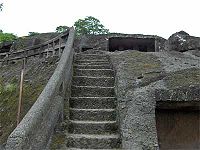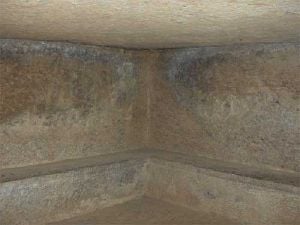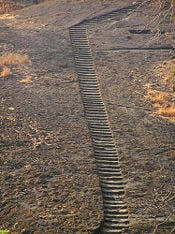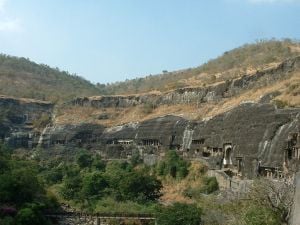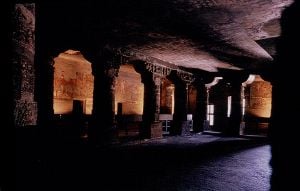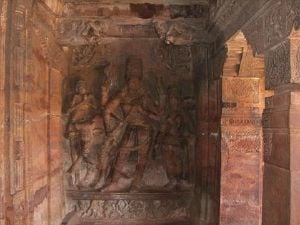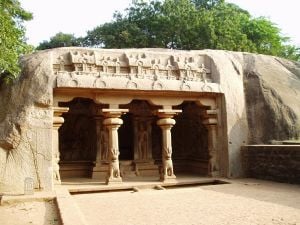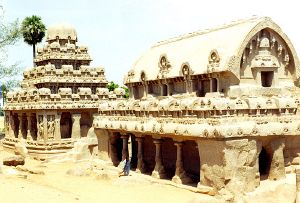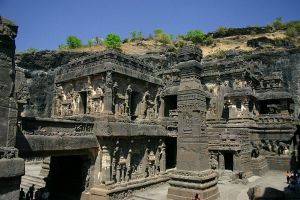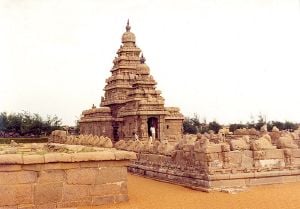Difference between revisions of "Indian rock-cut architecture" - New World Encyclopedia
John Gomis (talk | contribs) |
John Gomis (talk | contribs) |
||
| Line 1: | Line 1: | ||
| − | {{images OK}} | + | {{ready}} {{images OK}} |
| + | |||
<!-- [[Image:Kanheri steps.jpg|thumb|right|Carved stair at [[Kanheri Caves]]]] —> | <!-- [[Image:Kanheri steps.jpg|thumb|right|Carved stair at [[Kanheri Caves]]]] —> | ||
<!-- [[Image:Kanheri4.jpg|thumb|right|[[Kanheri Caves]] 1rst century to 9th century C.E.]] —> | <!-- [[Image:Kanheri4.jpg|thumb|right|[[Kanheri Caves]] 1rst century to 9th century C.E.]] —> | ||
Revision as of 23:12, 28 June 2008
Indian rock-cut architecture is more various and found in greater abundance than any other form of rock-cut architecture around the world.[1] Rock-cut architecture is the practice of creating a structure by carving it out of solid natural rock. Rock that is not part of the structure is removed until the only rock left are the architectural elements of the excavated interior. Indian rock-cut architecture is mostly religious in nature.[2] In India, caves have long been regarded as places of sanctity. Caves that were enlarged or entirely man-made were felt to hold the same sanctity as natural caves. In fact the sanctuary in all Indian religious structures, even free standing ones, retain the same cave-like feeling of sacredness, being small and dark without natural light.[3]
The earliest cave temples are found in the western Deccan, mostly Buddhist shrines and monasteries, dating between 100 B.C.E. and 170 C.E. They were probably preceded as well as accompanied by wooden structures which are destroyed over time while stone endures. Throughout the history of rock-cut temples, the elements of wooden construction have been retained. Skilled craftsmen learned to mimic timber texture, grain and structure. The earliest cave temples include the Bhaja Caves, the Karla Caves, the Bedse Caves, the Kanheri Caves and some of the Ajanta Caves. Relics found in these caves suggest an important connection between the religious and the commercial, as Buddhist missionaries often accompanied traders on the busy international trading routes through India. Some of the more sumptuous cave temples, commissioned by wealthy traders, included pillars, arches, and elaborate facades during the time maritime trade boomed between the Roman Empire and south-east Asia.[4]
Although free standing structural temples were being built by the 5th century, rock-cut cave temples continued to be built in parallel. Later rock-cut cave architecture became more sophisticated as in the Ellora Caves, culminating ultimately the monolithic Kailash Temple. After this, rock-cut architecture became almost totally structural in nature (although cave temples continued to be built until the 12th century), made from rocks cut into bricks and built as free standing constructions. Kailash was the last spectacular rock-cut excavated temple.[5]
Early caves
The earliest caves employed by humans were natural caves used by local inhabitant for a variety of purposes such as shrines and shelters. The early caves included overhanging rock decorated with rock-cut art and the use of natural caves during the Mesolithic period (6000 B.C.E.). Their use has continued in some areas into historic times.[6] The Rock Shelters of Bhimbetka, a World Heritage Site, are on the edge of the Deccan Plateau where deep erosion has left huge sandstone outcrops. The many caves and grottos found there contain primitive tools and decorative rock paintings that reflect the ancient tradition of human interaction with their landscape, an interaction that continues to this day.[7]
Cave temples
When Buddhist missionaries arrived they naturally gravitated to caves for use as cave temples and abodes, in accord with their religious ideas of asceticism and the monastic life. The Western Ghats topography with its flat-topped basalt hills, deep ravines and sharp cliffs, was suited to their natural inclinations. The earliest of the Kanheri Caves were excavated in the 1rst and 2nd centuries B.C.E. as were those at Ajanta which were occupied continuously by Buddhist monks from 200 B.C.E. to 650 C.E.[8][9] The Buddhist ideology encouraged identification with trade, monasteries became stopovers for inland traders and provided lodging houses that were usually located near trade routes. As their mercantile and royal endowments grew, cave interiors became more elaborate with interior walls decorated with paintings and reliefs and intricate carvings. Facades were added to the exteriors as the interiors became designated for specific uses as monasteries (viharas) and worship halls (chaityas). Over the centuries simple caves began to resemble three-dimensional buildings, needing to be formally designed and requiring highly skilled artisans and craftsmen to complete. Theses artisans had not forgotten their timber roots and imitated the nuances of a wooden structure and the wood grain in working with stone.[10]
Early examples of rock cut architecture are the Buddhist and Jain cave basadi, temples and monasteries, many with chandrashalas. The aesthetic nature of these religions inclined their followers to live in natural caves and grottos in the hillsides, away from the cities, and these became enhanced and embellished over time. Although many temples, monasteries and stupas had been destroyed, by contrast cave temples are very well preserved as they are both less visible and therefore less vulnerable to vandalism as well as made of more durable material than wood and masonry. There are around 1200 cave temples still in existence, most of which are Buddhist. The residences of monks were called Viharas and the cave shrines, called Chaityas, were for congregational worship.[10] The earliest rock-cut garbhagriha, similar to free-standing ones later, had an inner circular chamber with pillars to create a circumambulatory path (pradakshina) around the stupa and an outer rectangular hall for the congregation of the devotees.
The Ajanta Caves in Maharashtra, a World Heritage Site, are 30 rock-cut cave Buddhist temples carved into the sheer vertical side of a gorge near a waterfall-fed pool located in the hills of the Sahyadri mountains. Like all the locations of Buddhist caves, this one is located near main trade routes and spans six centuries beginning in the 2nd or 1st century B.C.E.[11] A period of intense building activity at this site occurred under the Vakataka king Harisena between 460 and 478 A profuse variety of decorative sculpture, intricately carved columns and carved reliefs are found, including exquisitely carved cornices and pilaster.[12] Skilled artisans crafted living rock to imitate timbered wood (such as lintels) in construction and grain and intricate decorative carving, although such architectural elements were ornamental and not functional in the classical sense.[10]
Another example of cave temple architecture are the Badami Cave Temples at Badami, the early Chalukya capital, carved out in the 6th century. There are four cave temples hewn from the sides of cliffs, three Hindu and one Jain, that contain carved architectural elements such as decorative pillars and brackets as well as finely carved sculpture and richly etched ceiling panels. Nearby are many small Buddhist cave shrines.[13]
Monolithic rock-cut temples
The Pallava architects started the carving of rock for the creation of a monolithic copies of structural temples.[3] A feature of the rock-cut cave temple distribution until the time of the early Pallavas is that they did not move further south than Aragandanallur, with the solitary exception of Tiruchitrapalli on the south bank of the Kaveri River, the traditional southern boundary between north and south. Also, good granite exposures for rock-cut structures were generally not available south of the river.[5]
A rock cut temple is carved from a large rock and excavated and cut to imitate a wooden or masonry temple with wall decorations and works of art. Pancha Rathas is an example of monolith Indian rock cut architecture dating from the late 7th century located at Mamallapuram,a UNESCO World Heritage Site.
Ellora cave temple 16, the Kailash Temple, is singular in that it was excavated from the top down rather than by the usual practice of carving into the scarp of a hillside. The Kailash Temple was created through a single, huge top-down excavation 100 feet deep down into the volcanic basaltic cliff rock. It was commissioned in 8th century by King Krishna I and took more than 100 years to complete.[14] The Kailash Temple, or cave 16 as it is known at Ellora Caves located at Maharastra on the Deccan Plateau, is a huge monolithic temple dedicated to Lord Shiva. There are 34 caves built at this site, but the other 33 caves, Hindu, Buddhist, and Jain, were carved into the side of the plateau rock. The effect of the Kailash Temple is that of a free-standing temple surrounded by smaller cave shrines carved out of the same black rock. The Kailash Temple is carved with figures of gods and goddesses from the Hindu Puranas, along with mystical beings like the heavenly nymphs and musicians and figures of good fortune and fertility.[15] Ellora Caves is also a World Heritage Site.[16]
Free-standing temples
There is no time line that divides the creation of rock-cut temples and free-standing temples built with cut stone as they developed in parallel. The building of free-standing structures began in 5th century, while rock cut temples continued to be excavated until the 12th century. An example of a free-standing structural temple is the Shore Temple, with its slender tower, built on the shore of the Bay of Bengal with finely carved granite rocks cut like bricks and dating from the 8th century.[12][17] It is considered to be part of Group of Monuments at the Mahabalipuram UNESCO World Heritage Site
Cave and temples examples
- Aihole has one Jaina and one Brahmanical temple.
- Badami Cave Temples
- Ellora Caves has twelve Buddhist, 17 Hindu and five Jain temples.[18]
- Kanheri Caves
- Mahabalipuram
- Pancha Rathas
- Shore Temple - structural
- Undavalli caves
- Varaha Cave Temple at Mamallapuram
See also
- List of India cave temples
- Rock-cut architecture
Notes
- ↑ History of Architecture - Early civilizations. historyworld.net. Retrieved 2006-12-18.
- ↑ Architecture of the Indian Subcontinent - glossary. indoarch.org. Retrieved 2006-12-18.
- ↑ 3.0 3.1 Michael, George (1988). The Hindu Temple. Chicago, Illinois: University of Chicago, pp 69, 82. ISBN 0226532305.
- ↑ Keay, John (2000). India: A History. New York: Grove Press, pp 103, 124-127. ISBN 0802137970.
- ↑ 5.0 5.1 Rajan, K.V. Soundara (1998). Rock-cut Temple Styles`. Somaily Publications, pp 9-10, 23, 160-161. ISBN 81 7039 218 7. Cite error: Invalid
<ref>tag; name "rockcut" defined multiple times with different content - ↑ Prehistoric Rock Art. art-and-archaeology.com. Retrieved 2006-10-17.
- ↑ Rock Shelters of Bhimbetka. Retrieved 2006-12-20.
- ↑ World Heritage Site - Ajanta Caves. Retrieved 2007-04-12.
- ↑ Ajanta Caves. Retrieved 2007-04-12.
- ↑ 10.0 10.1 10.2 Architecture of the Indian Subcontinent - Classification of Indian Architecture through the Ages. www.indoart.org. Retrieved 2007-06-26.
- ↑ Ajanta. Retrieved 2006-12-21.
- ↑ 12.0 12.1 Thapar, Binda (2004). Introduction to Indian Architecture. Singapore: Periplus Editions, pp 36-37, 51. ISBN 0794600115.
- ↑ Badami (Western Chalukya). art-and-archaeology.com. Retrieved 2006-12-21.
- ↑ Monuments of India. Retrieved 2006-12-21.
- ↑ Kailash Rock Cut Temple. Retrieved 2007-01-26.
- ↑ Ellora UNESCO World Heritage Site. Retrieved 2006-12-19.
- ↑ Architectual of the Indian Subcontinent. Retrieved 2006-12-21.
- ↑ Ellora Caves. Encyclopedia Britannica. Retrieved 2006-12-21.
ReferencesISBN links support NWE through referral fees
- Dehejia, Vidya. (1972). Early Buddhist Rock Temples. Thames and Hudson: London. ISBN 0-500-69001-4.
- Rajan, K.V. Soundara (1998). Rock-Cut Temple Styles. Somaiya Publications: Mumbai. ISBN 81-7039-218-7
External links
All Links Retrieved June 28, 2008
- Photos of rock-cut Bhaja cave
- History of Architecture Site
- Architectural Styles
- New York Times article 'Rock-cut temple of the many faced God', August 19, 1984
- St. Olaf College Art Course Handouts
- Ellora Caves UNESCO World Heritage Site
- Group of Monuments at Mahabalipuram UNESCO World Heritage Site
- Elephanta Caves UNESCO World Heritage Site
- UNESCO World Heritage: Rock Shelters of Bhimbetka
- Indian rock cut temples
- In the Holy Caves of India
- Photographs of Indian rock cut architecture and other sites
- Kailesh Rock Cut Temple
- Kerala Temple Architecture
- Pallava Art and Architecture
- Cave architecture
Credits
New World Encyclopedia writers and editors rewrote and completed the Wikipedia article in accordance with New World Encyclopedia standards. This article abides by terms of the Creative Commons CC-by-sa 3.0 License (CC-by-sa), which may be used and disseminated with proper attribution. Credit is due under the terms of this license that can reference both the New World Encyclopedia contributors and the selfless volunteer contributors of the Wikimedia Foundation. To cite this article click here for a list of acceptable citing formats.The history of earlier contributions by wikipedians is accessible to researchers here:
The history of this article since it was imported to New World Encyclopedia:
Note: Some restrictions may apply to use of individual images which are separately licensed.
